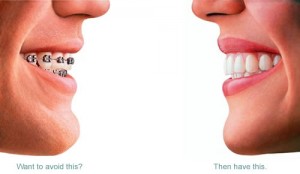Braces is considered as one of the orthodontic treatment.  Do you feel too old for braces? No, you are not!  There is no age limit for braces. Many people are born with misaligned teeth and with these “ugly” teeth/malocclusion , many feels highly self-conscious and turns into introvert because of this. Not only that, these malocclusion can gives temperomandibular joints problems, periodontal disease, risk of trauma for teeth that are severely proclined,  difficulty in speech, deglutition, risk of tooth decay and poor facial appearance.Â
What is the difference between a dentist and an orthodontist?
An orthodontist is a dentist who has taken several years of extra training beyond the basic dental degree. Here is what the American Association of Orthodontists (AAO) says:
“It takes many years to become an orthodontist. As in medicine, the educational requirements are demanding.
First, an orthodontist must complete college.
Next is a three- to four-year graduate program at a dental school in a university or other institution accredited by the American Dental Association (ADA).
Finally, there are at least two or three years of advanced specialty education in an ADA-accredited orthodontic residency program. The program is difficult. It includes advanced knowledge in biomedical, behavioral and basic sciences. The orthodontic resident learns the complex skills required to both manage tooth movement (orthodontics) and guide facial development (dentofacial orthopedics).
Only dentists who have successfully completed this advanced specialty education may call themselves orthodontists.”
Many orthodontists believe in the concept of ” catch them young”. Treating a patient at an early age when dento-facial growth is active has numerous benefits. However, in recent times there has been an increase in the number of adult patients who desire orthodontic treatment. There are some differences in which the patient has the rights to know before the treatment.
Growth to work with : One of the important differences in treating a child and an adult is the fact that in a child, an orthodontist has growth to work with. Most orthodontic treatment is efficiently carried out using the growth potential of the patient. In comparison, an adult lacks growth. This the orthodontist merely relies on tooth movement or surgery
Appliance Selection : Younger patient tolerate most appliances and are not bothered by the appearance of the appliances. In case of adults, the appliance tolerance is much lesser than a child. Adults are often bothered by the look of the appliances. Thereby, Invisalign and Lingual Braces are introduced.
Your motivation and cooperation : Â Most adult patients seeking orthodontic treatment are well motivated as compared to children. Thereby, orthodontist expect more cooperation in an adult patient.
Treatment appreciation : Adult patients are more appreciative of the treatment results than a child patient.

